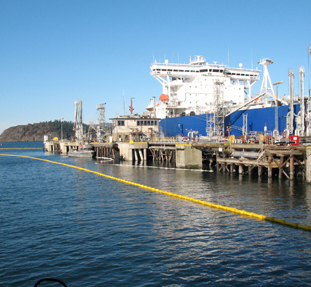Pre-booming, alternative measures, and equivalent compliance
While our first priority is preventing spills from occurring, pre-booming oil transfers is the state’s first line of defense if a spill should happen. During bulk oil-transfer operations, we require use of oil spill containment boom or alternative protective measures to protect state waters from spills.
Oil spill containment boom is a floating barrier used to temporarily corral and contain spilled oil on the water’s surface until it can be removed. Pre-booming refers to the deployment of boom prior to an oil-transfer operation, so that any spills during the transfer are contained instead of spreading to open waters.
Pre-booming requirements
We divide oil transfers into two categories:
- Rate A — product is transferred at a rate greater than 500 gallons per minute
- Rate B — product is transferred at a rate that is 500 gallons or less per minute
Any Rate A transfers being conducted by a regulated facility or vessel must pre-boom if it is safe and effective to do so. If weather and water conditions or other factors don't allow the deployment of boom, then facilities and vessels must comply with alternative measures to contain potential spills. All Rate B transfers being conducted by regulated facilities or vessels may pre-boom or comply with the appropriate alternative measures.
When pre-booming, the boom must completely surround the vessel or facility dock area directly involved in the oil transfer operation, or the area which would provide for maximum containment of any oil spilled into the water.
Highly volatile oils, such as gasoline, aviation gasoline, ethanol, and nonene do not require pre-booming, because collecting these oils in a tight space increases the risk of fire or explosion. If multiple products are transferred simultaneously and one of the products transferred is highly volatile, then the alternative measures criteria must be met. Boom must be deployed if there are at least 3 hours remaining in the transfer after the highly volatile product transfer is complete.
Additional requirements
The vessel delivering oil is required to supply the boom and deploy it before the transfer begins, and to retrieve it when the transfer is finished. There are several oil spill cleanup companies that provide boom service.
| Facility type | Examples |
|---|---|
| Class 1 | Large, fixed shore-side facilities such as refineries and refueling terminals. |
| Class 2 | Mobile facilities such as tank trucks, rail cars and portable tankers. |
| Class 3 | Oil-handling operations such as small tank farms and terminals that transfer oil to non-recreational vessels with fuel capacity above 10,500 gallons. |
| Class 4 | Marinas and small fueling stations that transfer oil to non-recreational vessels with fuel capacity below 10,500 gallons. |
We require Class 1, 2, and 3 facilities to pre-boom according to the rate A or rate B requirements. Class 4 facilities are not required to pre-boom transfers, although they may elect to do so.
Alternative measures
Our rules allow alternative measures to be taken when pre-booming is unsafe or ineffective. Rate A and Rate B transfer alternative measures can differ.
Equivalent compliance plans
We allow delivering facilities or vessels to propose innovative or special measures that can be taken in place of appropriate alternative measures. An equivalent compliance plan should be site-specific and must provide protection that is equivalent or better than the alternative measures. The plan must be submitted 120 days prior to planned use of the proposed equivalent measures for review and approval. All equivalent compliance plans will be subject to a 30-day public review and comment period.
These plans can't be used as a substitute for any rate A or rate B pre-booming requirements.
Additional information on equivalent compliance plans can be found in the equivalence compliance plan rules, Chapter 173-180-070 WAC or Chapter 173-184-105 WAC.
Related links
Contact information
Jason Reichert
Oil Transfer Inspector
jason.reichert@ecy.wa.gov
360-584-2799
Dan Ferguson
Facility Engineer Lead
dan.ferguson@ecy.wa.gov
360-480-9543


